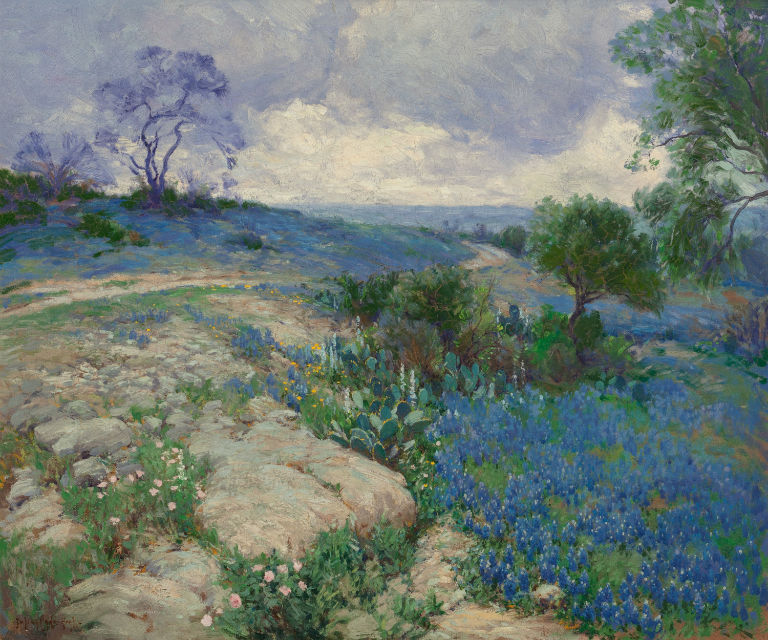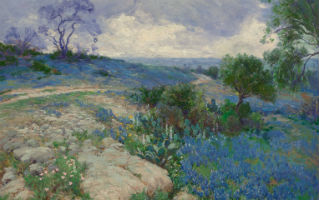
HOUSTON (AP) – A sea of yellow wildflowers recently cast a magical glow upon the flat pastureland just east of the Brazos River at Highway 290, but a dose of reality awaited on the west side of the bridge, under the “Welcome to Washington County” sign that usually draws a crowd this time of year: no hill of bluebonnets.
The Houston Chronicle reports across the county’s bucolic, rolling pastures—typically the closest bluebonnet haven to Houston—the wildflowers are prolific in some roadside patches but not blanketing the landscape profusely. So much for the popular misconception that Hurricane Harvey’s deluges created ideal conditions for a spectacular show of the state flower.
Overall, the 2018 spring wildflower season is on track to be “perfectly average” in many parts of Texas, say experts at the University of Texas at Austin’s Lady Bird Johnson Wildflower Center.
Slightly more ephemeral than other wildflowers that can linger into June, bluebonnets tend to peak during the first two weeks of April.
Their season is on schedule, but the display hinges on a lot of things, including the timing and intensity of rainfall and temperatures during the fall, winter and early spring. In spite of Harvey, the state’s key bluebonnet regions saw below-average rainfall during the prime seed germination months of October and November.
Andrea DeLong-Amaya, the wildflower center’s horticulture director, said the Austin area’s rainfall is about 4 inches below average for the year. “It was looking good early in the season for bluebonnets, but I’ve seen plants drying up, so they’re not flourishing,” she said. On the plus side, she expects to see bumper crops of phlox and pink evening primroses this season. “Every year the conditions shift,” she said.
Humans impact the wildflower environment, too. DeLong-Amaya said several pastures near Austin that have always provided a spring show are now construction sites, evidence of the city’s continual expansion.
Well out into the country, however, some area ranchers mow pastures to discourage visitors from trespassing into areas that also harbor ants, poisonous snakes and livestock, said Jenny Mills, tourism director for the Brenham/Washington County Chamber/CVB.
Ranchers may also mow wildflowers for the health of their livestock. “For big, fat cows, you need grasses, not flowers,” DeLong-Amaya said. That iconic postcard image—a longhorn standing in a field of bluebonnets and prickly pear cactus—tells her cattle are being overgrazed, because opportunistic flowers take over where there’s a dearth of grass.
She has been irked, however, to see a field near her home mowed under in the middle of wildflower season. “Maybe it’s an absentee landlord who doesn’t know, but you think, what a curmudgeon, not waiting a few weeks,” she said.
Dale Ramey, who owns the 26-year-old Bluebonnet House gift shop in Chappell Hill, understands the predicament of property owners who don’t want the liability of kids in flip-flops trouncing through their fields.
“People from the city come up here and think this world is all open to them,” she said. “They don’t understand what a barbed-wire fence is.” Several of her neighbors have already reported seeing deadly copperhead snakes this season.
But Ramey, like many other area merchants, also depends on bluebonnets for business.
“This is our Christmas,” she said.
Hotel-motel taxes in Washington County declined more than 12 percent from 2013 to 2016 for a number of reasons including storms and malaise of Houston’s oil economy. But the tax revenues spiked significantly in March and April during those years. Mills, who said the tourist economy is showing improvement, knows bluebonnets are an important attraction but said the spring antiques shows that consume about 30 miles of Highway 237 in neighboring Fayette County in late March and early April also are a big draw, as is the lure of clean, open air during the blissful months of spring.
Classic bluebonnet views are still out there, Mills said, but to help protect them, the chamber doesn’t publicize them. She recommends simply heading out into the county and seeking roads less traveled to find the expansive scenery.
The Wildflower Watch page at visitbrenhamtexas.com includes a map to public bluebonnet fields in and out of town where it’s safe to park. Several large fields behind businesses in Brenham are flush with blossoms that make fine backdrops for portraits. More rustic scenery is easy to access at Washington-on-the-Brazos State Park, between Brenham and Navasota; and Old Baylor Park in Independence.
Good season or bad, for most people, no image says “Texas” more than a picture of earthy blue heaven stretching to the horizon—a romantic vision that has proliferated since the 19th century, when landscape artists trekked through the state every spring with their easels.
Well before the age of Facebook and Instagram, bluebonnets inspired their own genre of painting and became a nearly obligatory backdrop for annual family photographs. But if Instagram numbers are any indication, the iconic flowers are more popular than ever: This week, the hashtag (hash)bluebonnets contained more than 170,000 images.
Professional nature photographer Theresa DiMenno, who lives in Houston, understands the appeal of the complex little wildflowers that can carpet pastures so prolifically they appear to mirror blue skies above.
Her bluebonnet epiphany came in 2009, when she was burned out from her wedding photography business and landed a plum project to help decorate Methodist Hospital’s buildings with images of Texas plants. On her first wildflower odyssey, she drove out 290 like so many other Houstonians and zigzagged through Washington County.
“I had my windows down, and music going, just looking for anything I could find—and I smelled them before I saw them,” she said. “It was the most intoxicating experience. Then I looked to my right, and there was this field that went on forever. I’d never seen anything like that.”
She was in Whitehall, near Navasota, beside a pasture where a crowd had already gathered to shoot through a barbed-wire fence. She drove a little farther, took a dirt road and serendipitously met the property owner, whom she befriended and still visits.
DiMenno, recently recognized as one of Texas Highways magazine’s 25 top travel photographers, now devotes several weeks each spring to a wildflower pilgrimage.
She usually starts close to home, at a patch of bluebonnets that pop up reliably next to a footbridge in Terry Hershey Park, her favorite local nature refuge. (That patch is already somewhat trampled, but Harvey’s flooding does not seem to have impacted it.)
“Every year, this little patch would come up first, and I’d go there just to get out and be with the flowers,” she said. “It’s quiet, and you hear the birds. It’s just a comforting, grounding spot to get started with the spring shooting.”
From there, she usually follows the progression of blooms as they appear, through Washington County and then into the Hill Country, where the season usually arrives a hair later.
She avoids the popular spots, never treads on private property without permission, and steps carefully to avoid crushing the show.
As DiMenno was recently contemplating her route for the year, Houstonians Gamaliel and Sandra Flores sat in a field behind the Saddle Shop, just south of 290 in Brenham. They’ve been married 20 years and have made wildflower trips before, but until this month had never taken a day off to revel in the bluebonnets.
It was midday, when the sun is harshest—a time professionals usually avoid, preferring the soft light of early morning or dusk.
The Floreses didn’t seem to care. The field they found wasn’t exactly flush, but it was enough. It was a perfect spring day, with a cloudless blue sky, and they were happy.
___
By MOLLY GLENTZER, Houston Chronicle
Information from: Houston Chronicle, http://www.houstonchronicle.com
Copyright 2018 Associated Press. All rights reserved. This material may not be published, broadcast, rewritten, or redistributed.
AP-WF-03-26-18 1552GMT



